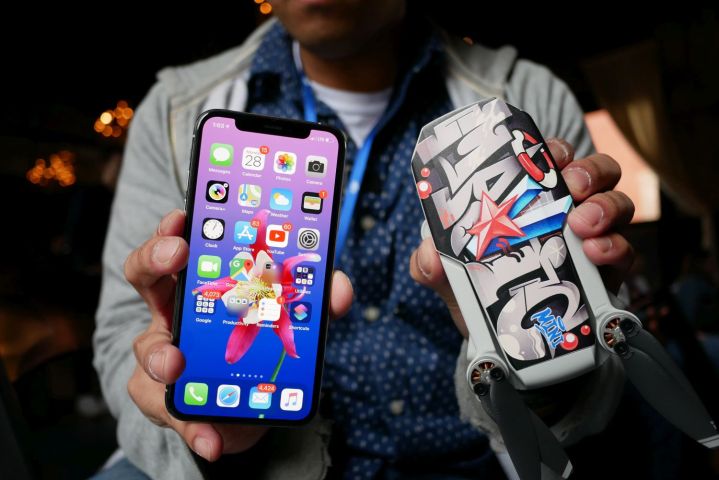The DJI Mavic Mini is not only the most affordable, entry-level option in the lineup, but also a true consumer-friendly option. Pricing, high learning curves, and flight restrictions have held back the vast majority of people who are eager to invest in a drone. The DJI Mavic Mini pushes those problems aside.
A drone in the palm of your hand
Drones in have shrunk in size with each new iteration, so it’s no surprise that the Mavic Mini sets a new, very small bar, becoming the lightest and most compact consumer drone DJI has made to date.

Yes, it adopts many of the design cues from previous drones in the Mavic series, but it’s all in a slightly more compact frame. That’s due to how the propeller arms collapse into the drone, similar to the Mavic Air, making it easy to carry in a backpack or even a small messenger bag.
That alone makes it worthwhile over other drones, because it’s something you can pack along on a weekend trip without being burdened by the heft that typically accompanies a drone.

What’s really remarkable is the Mavic Mini’s weight of 249 grams. That easily bests the 430 gram weight of the DJI Mavic Air before it. It’s absurdly light.
The Mavic Mini’s compact and lightweight frame is due to its plastic construction, which doesn’t feel as solid as previous drones. My concern about this, along with the weight, is that it will have some trouble staying stabilized when it’s at high altitude or in windy weather conditions. However, I had no problems in my time piloting it.
Lots of features, but no 4K
Earlier leaks indicated that the Mavic Mini would be rocking a camera setup that would record footage in crisp 4K resolution, much like some of the previous drones, but it’s instead outfitted with a 12-megapixel 1/2.3-inch sensor that tops out at 2.7K video capture at 30 FPS.
Considering that 4K capture has been ubiquitous among drones and other consumer level cameras, I was a bit taken aback by DJI’s decision. There’s also the option to record video at 1080p 60 FPS, which is useful for slowing/speeding up footage in post.

While it’s certainly enough to produce stunning landscape shots, it’s limiting in post production when it comes to editing video. Obviously this isn’t an issue for those producing clips for YouTube, but video editors just won’t have as much flexibility with the footage in post as they would with 4K clips.
However, the DJI Mavic Mini offers many signature features the company has developed. There’s sports mode for experienced pilots, rocket mode for quick vertical take-off, and circle mode, which tasks the drone with smoothly circling an area. L
It’s worth pointing out that the Mavic Mini doesn’t have a collision detection system due to cost and size constraints. Those who’ve become accustomed tothe feature in past drones will need to be more careful about piloting the Mini. A DJI representative stressed that pilots will need to have a direct line of sight when operating it.
Small size doesn’t impact battery or range
The smaller size made me worry about battery life. Luckily, that doesn’t seem to be an issue for the Mavic Mini, as it’s rated to deliver upwards of around 30 minutes of flight time. Of course that’ll vary, but it’s longer than the 20 minute rating of the Mavic Air. You have to give DJI credit for making such an improvement, especially with the drone’s lean figure.

Range isn’t compromised, either. In fact, it matches the advertised range of the Mavic Air, which extends to 4km (roughly 2.4 miles).
I was limited to piloting the drone to a couple hundred feet outdoors, and as I’d expect, there were no connectivity issues using the remote controller to pilot the Mavic Mini. It was responsive to my actions and piloting always felt smooth. For those with more experience, setting it to sport mode allows for tighter controls and serious acrobatic feats.
A drone for the masses
Consumers are still by in large intimidated at the prospect of buying and owning drones. The price is still prohibitive with many drones, as is the added requirement of registering them with the FAA. With the introduction of the DJI Mavic Mini, it eliminates the need for that — while also being an easier impulse buy because of its low cost.
This is a big deal, because it’s something that has broader reach among consumers, so they can simply buy and start enjoying the drone from the get-go. Of course, DJI insists that you still need to check local laws and regulations.
Conclusion
The sticker price of $399 makes the DJI Mavic Mini attractive. For that, you get the drone, remote controller, battery, extra propellers, and all the necessary tools to get you started. There’s also the Fly More Combo that tacks on a 360-degree propeller cage, a two-way charging hub, three batteries, three sets of extra propellers, and a carrying case.
Most gadgets that become smaller tend to have disadvantages, but the DJI Mavic Mini makes few compromises to achieve its downright compact design. You gain portability, while still enjoying the superb battery longevity and operating range found in the company’s other drones.
This is a drone you can take out of the box and immediately start flying without worry. If it’s able to deliver crisp footage, especially in low light, it may also be the first drone I ever buy.



